Add this eBook to your basket to receive access to all 469 records. Our indexes include entries for the spelling woodhead. In the period you have requested, we have the following 469 records (displaying 311 to 320): These sample scans are from the original record. You will get scans of the full pages or articles where the surname you searched for has been found. Your web browser may prevent the sample windows from opening; in this case please change your browser settings to allow pop-up windows from this site.  Sherwood Foresters fighting in Egypt
(1882) Sherwood Foresters fighting in Egypt
(1882)
The war medal roll for the Egyptian campaign of 1882 is annotated to show those men actually present at Tel-el-Kebir, and thereby also entitled to the Tel-el-Kebir clasp. In addition, there follows an almost duplicate roll of men entitled to the Bronze Star granted by the Khedive of Egypt in recognition of the campaign. The 2nd battalion, The Sherwood Foresters (Derbyshire Regiment), embarked from England to Gibraltar in 1881, and to Egypt early in 1882: by the end of the year they had sailed for India. This medal roll was compiled at Lucknow in December 1882. The battalion went on to take part in the Sikkim expedition of 1888, and the North West Frontier of India campaign of 1897 to 1898. | Sample scan, click to enlarge

| Boys entering Loretto School
(1883)
The Reverend Dr Thomas Langhorne, who came to Musselburgh in Midlothian as an Episcopalian Church clergyman, established a small school for boarders and day scholars at Loretto House, so called because the grounds contained the ruins of the mediaeval chapel of St Mary of Loretto. To celebrate the centenary of the school in 1925, a second edition of the school register was published, edited by A. H. Buchanan-Dunlop. Relatively little was known of many of the earliest scholars, but from 1835 onwards the register generally gives full name, in capitals, surname first; date of birth; period of time at Loretto; a brief biography; date of death; whether brother of any other boy in the register; and a sequential number. | Sample scan, click to enlarge
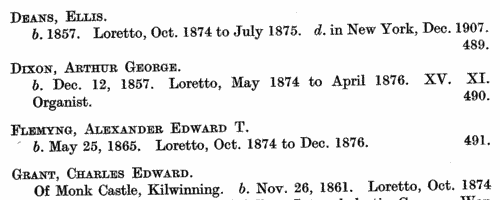
| Residents of Southport, Lancashire
(1883)
Slater's Royal National Directory of Southport and Birkdale with their Vicinities of 1883-4 includes this general alphabetical listing of residents and traders. | Sample scan, click to enlarge
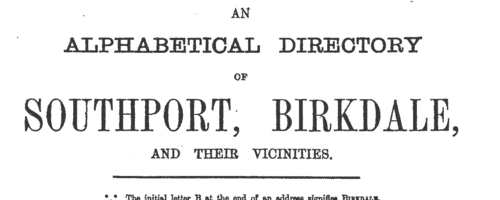
| Bankrupts
(1884)
In accordance with the Bankruptcy Act of 1883, notices received by the Board of Trade were gazetted in tabular form by the Inspector-General in Bankruptcy. At each stage the record gives the debtor's name, address (often including former addresses), description (i. e., occupation), the name of the court, and the sequential number of the matter in that court for the year. The tables of Receiving Orders additionally give Date of Order, Date of Petition and Date of Public Examination; notices of First Meeting give Date of Meeting, Hour and Place; Adjudications give Date of Order, Date of Petition, Name of Trustee (if appointed) and Address of Trustee; Notices of Intended Dividend give Last Day for Receiving Proofs, Name of Trustee, and Address; Notices of Dividends give Amount per Pound, When Payable, and Where Payable; Applications for Debtor's Discharge state the Day fixed for Hearing; and notices of Appointment of Trustees give the Trustee's Name, Address, and Date of Certificate of Appointment. Any one debtor would normally appear in a number of these tables as his or her case proceeded over the months. These are the notices gazetted in 1884.
| Sample scan, click to enlarge

| Boys entering Leeds Grammar School
(1884)
The admission books for Leeds Grammar School from 1820 to 1900 were edited by Edmund Wilson and published in 1906. The series of registers is almost complete for the period, there being in addition admission registers for the Lower (or Commercial) Department from 1856 to 1865, and lists of boys in the school in 1856, and in the Commercial Department in 1861. The entries are arranged by date or term of admission: a sequential number is given first, then surname, christian name, and, after a dash, father's christian name, occupation, and address; another dash, and then the age of the boy at admission, and often his year of leaving (with the abbreviation r. for 'removed' or 'left'). r.* means left without notice; (o) or S. or Stranger or Foreigner indicates a boy not on the foundation. The editor was unable to divine the meaning of the abbreviation (Q) or the asterisks prefixed to most entries in 1856 to 1860, but dutifully copies them into the text. In smaller type he then proceeds, where possible, to add some information about the boy's subsequent career. | Sample scan, click to enlarge
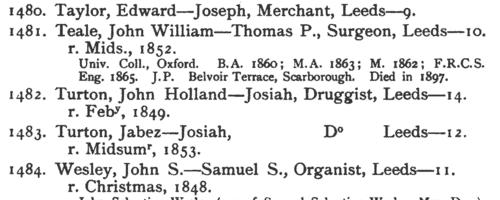
| Criminals Imprisoned
(1884)
Henry Romeike compiled this list of 800 cases, reported in the newspapers in March and April 1884, in which criminals were fined or imprisoned. The list is arranged by nature of the fine or length of sentence, divided into two groups: offences against property, and those against the person. The compilation was published by D. H. Macfarlane, M.P., to contrast the severity of sentences for theft of trivial property, as against relatively light punishments for assaults: it gives the full name of the criminal, brief details of the crime, and the name and date of the newspaper report. | Sample scan, click to enlarge
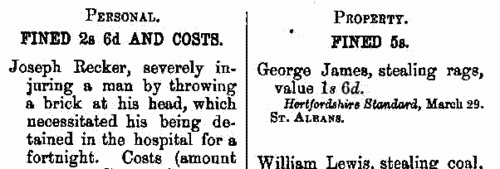
| Shorthand Writers
(1884)
Lists of members of the Phonetic Society, reports of Shorthand Writers Association and other meetings, news and advertisements, from the Phonetic Journal. | Sample scan, click to enlarge

| History students at Cambridge University
(1885)
Tripos lists or examination results for the year, arranged by class (First, Second and Third), and within each class in order of score in the examination (students getting exactly equal marks are bracketed together). Each student's surname and college is given: this list was printed in 1890, and was annotated with asterisks to show which students had subsequently become fellows of the university; and with footnotes showing those who became headmasters, &c., elsewhere. Women students are listed on the same basis, but separately, but for each an indication is given as to where precisely she stood in terms of merit among the male students. These lists are particularly useful in identifying for an individual the fellow-students who will have attended lectures with him; and, where from the college, are likely to have been even more closely associated by having been under the same supervisor. (The sample scan is from the start of the Mathematics Tripos list for 1770) | Sample scan, click to enlarge

| Justices of the Peace, Huddersfield
(1885)
"Return giving the Names and Professions of all Justices of the Peace in the Boroughs and Cities of England and Wales, on the 1st day of June 1885, with the Dates of their Appointment; showing which were Non-resident, or had ceased for a Year or upwards to attend the Bench." | Sample scan, click to enlarge
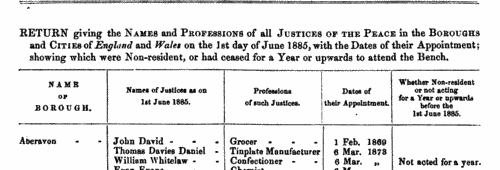
| Shorthand Writers
(1885)
Lists of members of the Phonetic Society, reports of Shorthand Writers Association and other meetings, news and advertisements, from the Phonetic Journal. | Sample scan, click to enlarge
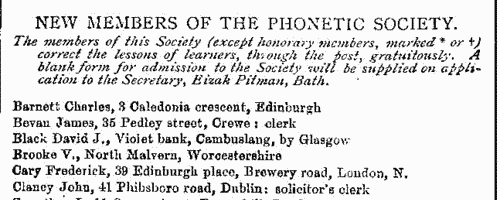
|
Research your ancestry, family history, genealogy and one-name study by direct access to original records and archives indexed by surname.
|












